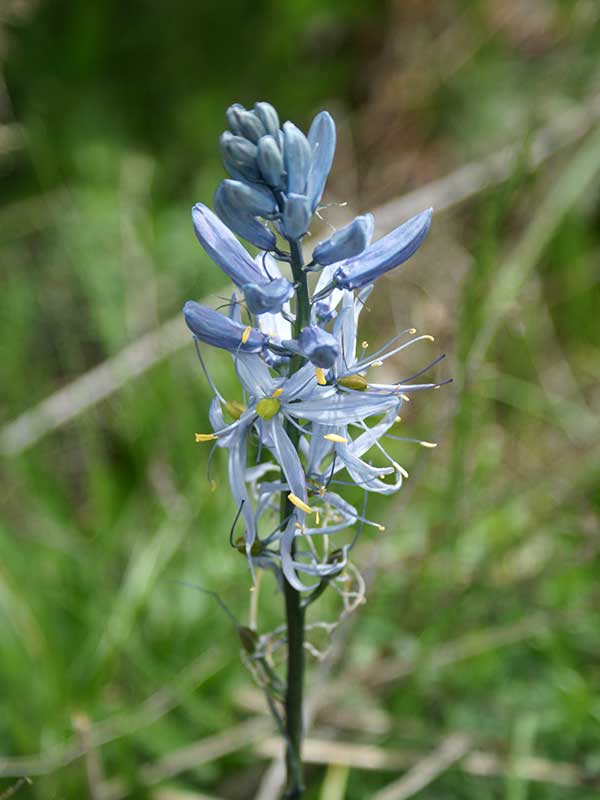Camassia quamash / small camas
- immediately visible for its star-shaped blue flowers and yellow anthers
- flowers borne on a spike-like raceme, opening from the bottom up
- multiple flowers open at one time
- leaves are grass-like, growing from a bulb
- large seed capsules with ca. 30 roundish black seeds, ripe in late summer
Also known as: camas, common camas, common camash, quamash
The small camas is a perennial herbaceous monocot. While it can grow up to 28 inches, most plants, especially in the Valley, are much shorter.
The leaves of small camas grow from a persistent bulb, forming a basal rosette. The bulbs can be up to 2 inches in diameter. The flowering stalk, or scape, also grows from the bulb. It is leafless.
The inflorescence of blue camas is a spike-like raceme at the end of the scape. The individual flowers are star-shaped, radially symmetrical and a beautiful blue. Each flower has 6 tepals, 6 stamens and 3 pistils. The stamens are tipped with yellow anthers. The individual flowers in the raceme open at different times, from the bottom up, but 3 or more can be open at one time. Peak flowering is in May.
As the flowers fade, they are replaced by a rather large seed capsule. Each capsule has 3 cells, each with 5-10 round, black seeds. The seeds are an important way of reproduction, but bulb offsets are also important.
Camas is limited in habitat to wet areas… wet meadows, prairies, swales, depressions, floodplains, seeps and streamsides. The habitat is often ephemeral, drying by late spring.
Though there are still a couple of reasonably large camas prairies in Idaho, especially around Fairfield and Hill City, in the Valley, the plants are scattered here and there.
Camas shoots are grazed by all the large herbivores in the area as they emerge. Gophers also eat camas and responsible for moving bulbs from one area to another where they sprout the next year.
Interesting bits – Small camas bulbs were one of the more important plant food sources for many tribes in the Pacific Northwest. They were kind enough to share these with the Lewis and Clark Expedition. Both the genus and specific names for the plant have Nez Perce language origin. The name means “sweet” and was also the term for the plant’s bulb. The bulbs were harvested and pit-roasted and there are many recipes for this on the web today.
Note: Due to loss of wetland habitat throughout the west, harvesting plants from the wild is rarely appropriate or legal except under salvage situations. Better by far is to collect a few seeds from any one area, or to buy seeds or bulbs from reputable nurseries. Indeed, the vast majority of the links that pop up from a web search for this species are for commercial sellers.
The result of the cooking process was to convert inulins to sugars, in particular, to fructose. Inulins belong to one class of dietary fibers, the fructans. They are used by the plant to store energy in roots; such plants don’t accumulate the more common polysaccharide, starch. After cooking, fully a third of the cooked weight is fructose.
With the exception of some varieties of dried salmon, camas bulbs were the most traded food items between families and tribes. The devastating effect of conversion of extensive camas prairies to farmland by the Europeans can not be underestimated.
| Color | |
|---|---|
| Family | |
| Blossom size | |
| Inflorescence size | |
| Inflorescence type | |
| When? | |
| Where? |

